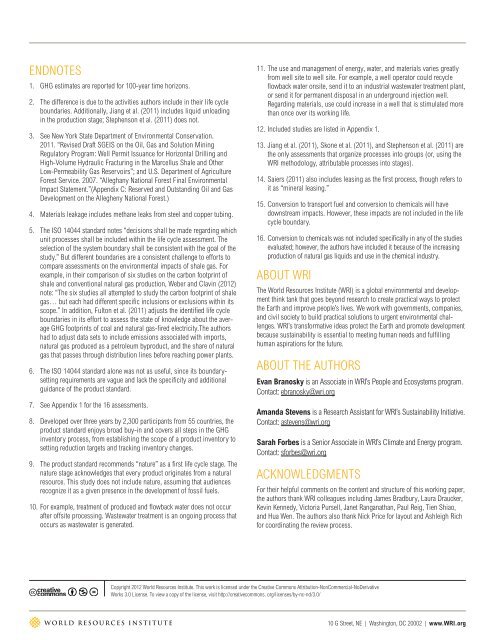defining the shale gas life cycle - World Resources Institute
defining the shale gas life cycle - World Resources Institute
defining the shale gas life cycle - World Resources Institute
Create successful ePaper yourself
Turn your PDF publications into a flip-book with our unique Google optimized e-Paper software.
ENDNOTES1. GHG estimates are reported for 100-year time horizons.2. The difference is due to <strong>the</strong> activities authors include in <strong>the</strong>ir <strong>life</strong> <strong>cycle</strong>boundaries. Additionally, Jiang et al. (2011) includes liquid unloadingin <strong>the</strong> production stage; Stephenson et al. (2011) does not.3. See New York State Department of Environmental Conservation.2011. “Revised Draft SGEIS on <strong>the</strong> Oil, Gas and Solution MiningRegulatory Program: Well Permit Issuance for Horizontal Drilling andHigh-Volume Hydraulic Fracturing in <strong>the</strong> Marcellus Shale and O<strong>the</strong>rLow-Permeability Gas Reservoirs”; and U.S. Department of AgricultureForest Service. 2007. “Alleghany National Forest Final EnvironmentalImpact Statement.”(Appendix C: Reserved and Outstanding Oil and GasDevelopment on <strong>the</strong> Allegheny National Forest.)4. Materials leakage includes methane leaks from steel and copper tubing.5. The ISO 14044 standard notes “decisions shall be made regarding whichunit processes shall be included within <strong>the</strong> <strong>life</strong> <strong>cycle</strong> assessment. Theselection of <strong>the</strong> system boundary shall be consistent with <strong>the</strong> goal of <strong>the</strong>study.” But different boundaries are a consistent challenge to efforts tocompare assessments on <strong>the</strong> environmental impacts of <strong>shale</strong> <strong>gas</strong>. Forexample, in <strong>the</strong>ir comparison of six studies on <strong>the</strong> carbon footprint of<strong>shale</strong> and conventional natural <strong>gas</strong> production, Weber and Clavin (2012)note: “The six studies all attempted to study <strong>the</strong> carbon footprint of <strong>shale</strong><strong>gas</strong>… but each had different specific inclusions or exclusions within itsscope.” In addition, Fulton et al. (2011) adjusts <strong>the</strong> identified <strong>life</strong> <strong>cycle</strong>boundaries in its effort to assess <strong>the</strong> state of knowledge about <strong>the</strong> averageGHG footprints of coal and natural <strong>gas</strong>-fired electricity.The authorshad to adjust data sets to include emissions associated with imports,natural <strong>gas</strong> produced as a petroleum byproduct, and <strong>the</strong> share of natural<strong>gas</strong> that passes through distribution lines before reaching power plants.6. The ISO 14044 standard alone was not as useful, since its boundarysettingrequirements are vague and lack <strong>the</strong> specificity and additionalguidance of <strong>the</strong> product standard.7. See Appendix 1 for <strong>the</strong> 16 assessments.8. Developed over three years by 2,300 participants from 55 countries, <strong>the</strong>product standard enjoys broad buy-in and covers all steps in <strong>the</strong> GHGinventory process, from establishing <strong>the</strong> scope of a product inventory tosetting reduction targets and tracking inventory changes.9. The product standard recommends “nature” as a first <strong>life</strong> <strong>cycle</strong> stage. Thenature stage acknowledges that every product originates from a naturalresource. This study does not include nature, assuming that audiencesrecognize it as a given presence in <strong>the</strong> development of fossil fuels.10. For example, treatment of produced and flowback water does not occurafter offsite processing. Wastewater treatment is an ongoing process thatoccurs as wastewater is generated.11. The use and management of energy, water, and materials varies greatlyfrom well site to well site. For example, a well operator could re<strong>cycle</strong>flowback water onsite, send it to an industrial wastewater treatment plant,or send it for permanent disposal in an underground injection well.Regarding materials, use could increase in a well that is stimulated morethan once over its working <strong>life</strong>.12. Included studies are listed in Appendix 1.13. Jiang et al. (2011), Skone et al. (2011), and Stephenson et al. (2011) are<strong>the</strong> only assessments that organize processes into groups (or, using <strong>the</strong>WRI methodology, attributable processes into stages).14. Saiers (2011) also includes leasing as <strong>the</strong> first process, though refers toit as “mineral leasing.”15. Conversion to transport fuel and conversion to chemicals will havedownstream impacts. However, <strong>the</strong>se impacts are not included in <strong>the</strong> <strong>life</strong><strong>cycle</strong> boundary.16. Conversion to chemicals was not included specifically in any of <strong>the</strong> studiesevaluated; however, <strong>the</strong> authors have included it because of <strong>the</strong> increasingproduction of natural <strong>gas</strong> liquids and use in <strong>the</strong> chemical industry.ABOUT WRIThe <strong>World</strong> <strong>Resources</strong> <strong>Institute</strong> (WRI) is a global environmental and developmentthink tank that goes beyond research to create practical ways to protect<strong>the</strong> Earth and improve people’s lives. We work with governments, companies,and civil society to build practical solutions to urgent environmental challenges.WRI’s transformative ideas protect <strong>the</strong> Earth and promote developmentbecause sustainability is essential to meeting human needs and fulfillinghuman aspirations for <strong>the</strong> future.ABOUT THE AUTHORSEvan Branosky is an Associate in WRI’s People and Ecosystems program.Contact: ebranosky@wri.orgAmanda Stevens is a Research Assistant for WRI’s Sustainability Initiative.Contact: astevens@wri.orgSarah Forbes is a Senior Associate in WRI’s Climate and Energy program.Contact: sforbes@wri.orgACKNOWLEDGMENTSFor <strong>the</strong>ir helpful comments on <strong>the</strong> content and structure of this working paper,<strong>the</strong> authors thank WRI colleagues including James Bradbury, Laura Draucker,Kevin Kennedy, Victoria Pursell, Janet Ranganathan, Paul Reig, Tien Shiao,and Hua Wen. The authors also thank Nick Price for layout and Ashleigh Richfor coordinating <strong>the</strong> review process.Copyright 2012 <strong>World</strong> <strong>Resources</strong> <strong>Institute</strong>. This work is licensed under <strong>the</strong> Creative Commons Attribution-NonCommercial-NoDerivativeWorks 3.0 License. To view a copy of <strong>the</strong> license, visit http://creativecommons. org/licenses/by-nc-nd/3.0/10 G Street, NE | Washington, DC 20002 | www.WRI.org
















